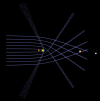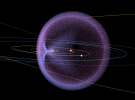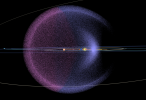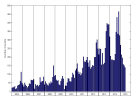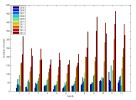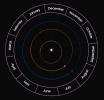tohuwabohu
Jedi Master
During the simulations time and again I made interesting observation that when something is thrown at the solar system (I mean some large pile of rocks here) the sun acts as a big gravitational lens. As the bodies approach the sun, they will be attracted and as a result a dense region is formed on the side of the sun that is opposite to the direction from which the rocks came.
The situation is illustrated in Fig. 53. For better clarity I arranged the bodies into rays that are moving from left to right. You can see that even though the rays are initially parallel to each other the sun simply changes their direction and focuses them into some small region. Here in the picture only two-dimensionsal representation is shown, in three dimensions the effect is extended into the third dimension in a straightforward manner. If you imagine the rays arranged into a tube with the sun on the axis of the tube then all the objects would be redirected towards the axis. Because the gravitational potential is a scalar it means that it has no direction and therefore all objects are pulled into the very same region that is on the opposite side of the sun.
The shape of the region is complex because unlike optical lens (properly shaped) the gravitational lens does not send the rays into one single point. Nevertheless the simulation indicate that the density (of the rocks) in the region is increased.
The situation is illustrated in Fig. 53. For better clarity I arranged the bodies into rays that are moving from left to right. You can see that even though the rays are initially parallel to each other the sun simply changes their direction and focuses them into some small region. Here in the picture only two-dimensionsal representation is shown, in three dimensions the effect is extended into the third dimension in a straightforward manner. If you imagine the rays arranged into a tube with the sun on the axis of the tube then all the objects would be redirected towards the axis. Because the gravitational potential is a scalar it means that it has no direction and therefore all objects are pulled into the very same region that is on the opposite side of the sun.
The shape of the region is complex because unlike optical lens (properly shaped) the gravitational lens does not send the rays into one single point. Nevertheless the simulation indicate that the density (of the rocks) in the region is increased.

